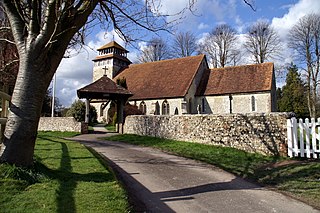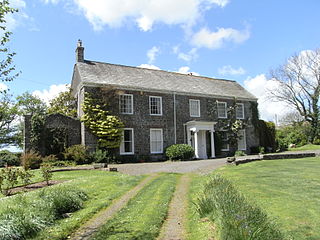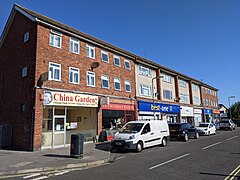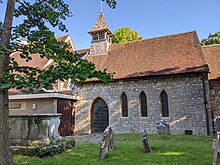History
As Roman burial shrouds were found in the grounds of the church, it would seem to indicate there was a presence in the area at the time. However, it is more generally accepted that a small hamlet was established between 700 and 900AD. The spelling of the place name differs slightly from its mention in The Anglo Saxon Charter and Domesday Book. At the time of Domesday Book of 1086 the manor of Rowner was held by William Mauduit. [1] The family of Mauduit seems to have been of considerable importance at this time as the possessor of large estates in Hampshire, and its members were among the chamberlains of Henry I and Henry II. [1] Bonn's edition of Anglo-Saxon Chronicle confirms that King Henry I, visited Rowner in 1114. In the 13th century Rowner passed out of the Mauduit family, and in 1240–1 Elias de la Falaise was holding land in Rowner. [1] He died in 1254, and his brother William died in possession of the manor in the same year. [1] Before 1277 the property had escheated to the Crown by the felony of William de la Falaise, grandson of William, and was granted in that year to Sir William le Brune, chamberlain to the king. [1] The manor then stayed solidly in the Brune family until the death of Charles Brune in 1769, when the family became extinct in the male line. [1] By his will his estates eventually devolved onto his grand-nephew the Rev. Charles Prideaux-Brune of Prideaux Place, Padstow, Cornwall, and it remained in the possession of the Prideaux-Brune family into the 20th century. [1]
The medieval church of Saint Mary the Virgin is the oldest church in Gosport, dating from the 12th century, however it was extensively modified in 1874. [1] The church was expanded in 1968 and then rebuilt in 1992 after a fire. [2] The 19th century Palmerston Forts of Fort Rowner, Fort Brockhurst, and Fort Grange, lie to the east and south. [1] According to the Anglo-Saxon Chronicle, Henry I held court in the parish in 1114 before boarding to travel to his estates in Normandy.
As the start of the 20th century the village of Rowner, only consisted of a small number of old cottages scattered over a long narrow strip of land, the southern and eastern portions of which had been bought by the War Office for the land defences of Portsmouth. [1]
Arriving by helicopter on 19th May 2000, Her Majesty Queen Elizabeth II, visited the engineering training centre at HMS Sultan in Rowner, taking the salute from 820 sailors, who were on parade with the Band of the Royal Marines.
On the 6th December 1966, a new housing estate complete with a thousand new flats, maisonettes and houses was opened as accommodation for service personnel and their families, along with a shopping precinct, that earned this side of Rowner the nickname, "The Concrete Jungle". These properties eventually passed into the ownership of the local council and Housing Associations, but were largely demolished in the early part of the 21st century during the £145, 000, 000 Rowner Renewal Scheme, which provided hundreds of more modern homes and commercial dwellings. Rowner has one of the largest BMX courses in the south of England, allowing the Gosport BMX Club, to compete in, and host national events such as the HSBC UK National BMX Series. Commercial premises in Rowner include a Tesco Superstore, a Subway, and that of The Alver Valley Garden Centre.
In 2011, Channel 4 filmed the Tony Robinson's God's And Monster's programme at Little Woodham 17th Century Village. In 2018, the same location was used for the BBC's Doctor Who episode The Witchfinders.
In 1931 the civil parish had a population of 105. [3] On 1 April 1932 the parish was abolished and merged with Alverstoke. [4] It is now in the unparished area of Gosport.

Fordingbridge is a town and broader civil parish with a population of 6,200 on the River Avon in the New Forest District of Hampshire, England. The Town is located near the Dorset and Wiltshire borders and on the edge of the New Forest.

Gosport is a town and non-metropolitan district with borough status, on the south coast of Hampshire, England. At the 2021 Census, the town had a population of 70,131 and the district had a population was 81,952. Gosport is situated on a peninsula on the western side of Portsmouth Harbour, opposite the city of Portsmouth, to which it is linked by the Gosport Ferry. Gosport lies south-east of Fareham, to which it is linked by a Bus Rapid Transit route and the A32. Until the last quarter of the 20th century, Gosport was a major naval town associated with the defence and supply infrastructure of His Majesty's Naval Base (HMNB) Portsmouth. As such over the years extensive fortifications were created.

Hartwell is a village and former civil parish, now in the parish of Stone with Bishopstone and Hartwell, in central Buckinghamshire, England. It is to the south of Aylesbury, by the village of Stone. In 1971 the civil parish had a population of 102. On 1 April 1986 the parish was abolished and merged with Stone to form "Stone with Bishopstone and Hartwell".

Brimpton is a mostly rural village and civil parish in West Berkshire, England. Brimpton is centred 4.5 miles (7.2 km) ESE of the town of Newbury.

Modbury is a large village, ecclesiastical parish, civil parish and former manor situated in the South Hams district of the county of Devon in England. Today due to its large size it is generally referred to as a "town" although the parish council has not elected to give itself the status of a town as it could do under s.245(6) of the Local Government Act 1972, so it does not have a town council and cannot have a town mayor. It is also known informally as a "market town", as from at least 1199 the lord of the manor has held the right to hold a regular market. The village is situated on the A379 road, which links it to Plymouth and Kingsbridge. The current parish population is approximately 1,500.

Damerham is a rural village and civil parish in the New Forest district of Hampshire, England, near Fordingbridge. The area has notable Neolithic and Bronze Age barrows. It was the site of an Anglo-Saxon religious community, mentioned in the will of Alfred the Great. By the time of Domesday Book (1086), Damerham was a major settlement in the possession of Glastonbury Abbey. The village has a riverside mill and a Norman church.

Meonstoke is a village and former civil parish, now in the parish of Corhampton and Meonstoke, in the Winchester district, in the county of Hampshire, England. It is in the Meon Valley where it cuts through the Middle Chalk of the South Downs, Old Winchester Hill is at the edge of the parish to the east. In 1931 the parish had a population of 439.

South Charford is a hamlet in the civil parish of Breamore, in the New Forest district, in Hampshire, England. It is on the west bank of the River Avon.

North Charford is a hamlet in the civil parish of Breamore, in the New Forest district, in Hampshire, England, near the Wiltshire border. Historically the name refers to a manor which is on the west bank of the River Avon.
Castlethorpe Castle stood in the village of Castlethorpe, to the north of Milton Keynes, Buckinghamshire.

Alverstoke is a village in the borough of Gosport, on the south coast of Hampshire, England. It stretches east–west from Fort Blockhouse, Haslar to Browndown Battery, and is centred 0.5 miles (0.80 km) east of the shore of Stokes Bay and near the head of a creek which extends a mile westward from Portsmouth Harbour.

Wolverton is a village in the civil parish of Baughurst, in the Basingstoke and Deane district in north Hampshire, England. It is approximately 7 miles (11 km) from both Newbury and Basingstoke.

Shalden is a village and civil parish in the East Hampshire district of Hampshire, England. It is 2.3 miles (3.7 km) northwest of Alton and 1.9 miles (3.1 km) northeast of Bentworth, just off the A339 road. The parish covers an area of 1,536 acres (622 ha) and has an average elevation of 600 feet (180 m) above sea level. The nearest railway station is Alton, 2.5 miles (4.0 km) southeast of the village. According to the 2011 census, it had a population of 435.

Netley Marsh is a village and civil parish in Hampshire, close to the town of Totton. It lies within the New Forest District, and the New Forest National Park. It is the supposed site of the battle between an invading Anglo Saxon army, under Cerdic and a British army under the probably fictitious king Natanleod in the year 508.
Azor was one of the most powerful English landowners at the time of Edward the Confessor in the 11th century. He was a kinsman and chamberlain of Brihtheah, a bishop of Worcester and a former abbot of Pershore. He owned property from Lincolnshire down to the Isle of Wight in many counties and like another great landowner of the times, Toki, he also owned urban property in addition to his vast possession of lavish country estates. He is mentioned in the Domesday Book and appears in countless histories of English counties along with his sons, Goscelin, William, and Henry who inherited his estates after his death. The sons in particular are linked with the early histories of many of the major manor houses on the Isle of Wight.
William de Falaise, also called William of Falaise, was a Norman from Falaise, Duchy of Normandy, today in the Calvados department in the Lower Normandy region of north-western France. He became feudal baron of Stogursey in Somerset and also held manors in Devon.
William de Courcy, feudal baron of Stoke Courcy in Somerset, was an Anglo-Norman nobleman.

Over Worton is a hamlet in the civil parish of Worton, in the West Oxfordshire district, in the county of Oxfordshire, England, about 7 miles (11 km) south of Banbury and 7+1⁄2 miles (12 km) east of Chipping Norton. In 1931 the parish had a population of 72. On 1 April 1932 the parish was abolished and merged with Nether Worton to form "Worton".

Thuborough in the parish of Sutcombe, Devon, England, is an historic estate, formerly a seat of a branch of the Prideaux family, also seated at Orcharton, Modbury; Adeston, Holbeton; Soldon, Holsworthy; Netherton, Farway; Ashburton; Nutwell, Woodbury; Ford Abbey, Thorncombe, all in Devon and at Prideaux Place, Padstow and Prideaux Castle, Luxulyan, in Cornwall. The present mansion house, comprising "Thuborough House" and "Thuborough Barton", the north-east block, is a grade II listed building.

Ascott is a hamlet and manor house in the civil parish of Stadhampton, in the South Oxfordshire district, in the county of Oxfordshire, England. Ascott lies close to the River Thame north-east of Dorchester, about 8 miles to the south-east of the centre of Oxford.


















